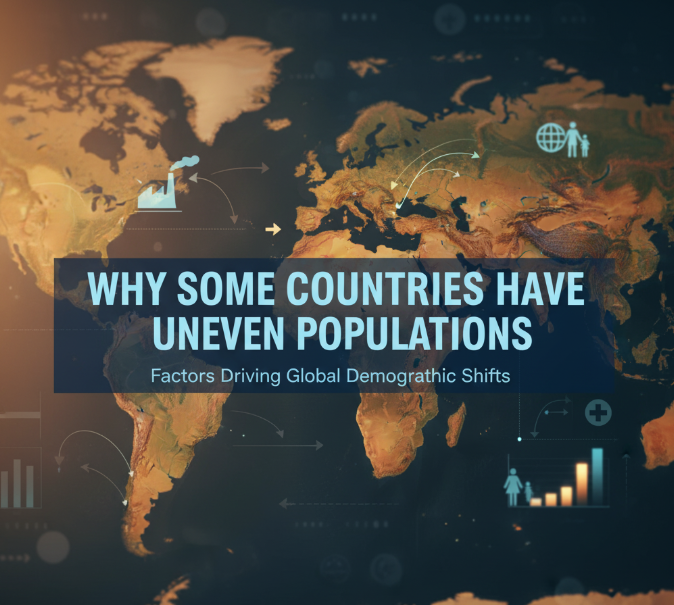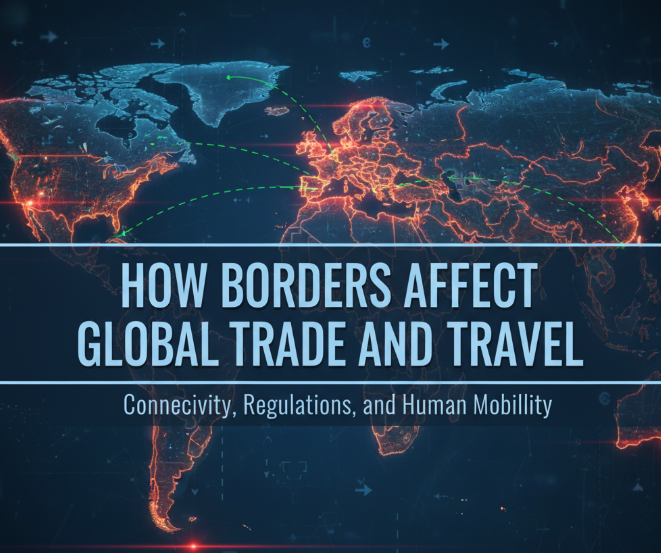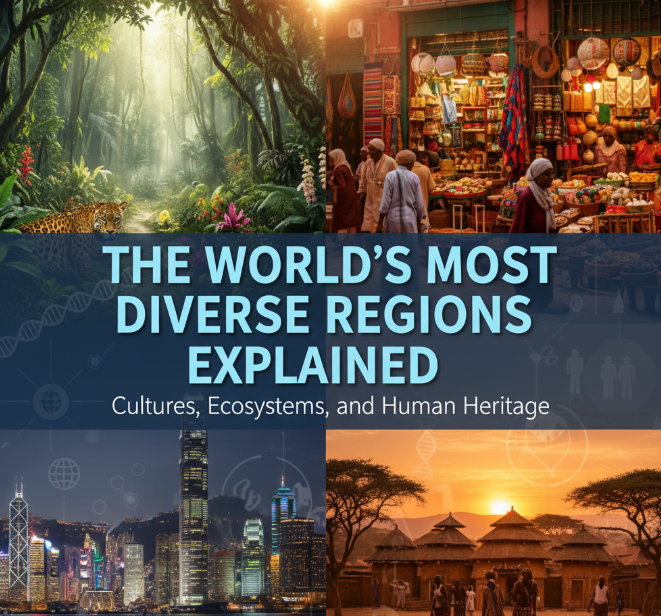Why is it that millions of people squeeze into noisy, polluted cities like Tokyo and Mumbai, while large expanses of land in countries such as Russia or Canada remain almost completely uninhabited? It is a fascinating puzzle that has implications for everything from job prospects to housing prices, from environmental health to political power.
Population distribution — how people settle throughout a country — is vastly different worldwide. Some countries concentrate the majority of their population in small spaces and have vast expanses nearly uninhabited. Others maintain a more even distribution. This uneven distribution isn’t random. It’s a combination of geography, climate, history, economics and human choice over centuries.
In this essay, we will discuss the true causes of these population patterns. You’ll learn why deserts repel people, how mountain ranges build barriers, why coastal areas flourish and how government policy can move entire millions to live elsewhere. By the end, you’ll be looking at your country — and the world as well — through an entirely different lens.
The Geography Factor: Nature as Stage Setter
Mountains That Divide Nations
Mountains not only make lovely scenery — they produce population barriers. In Asia, the Himalayan range, in South America, the Andes and in North America the Rocky Mountains all drastically divided populations.
Nepal offers a perfect example. More than 80% of its population resides in the southern lowland plains and central valleys, as it sprawls across the northern mountainous regions. Why? Mountain life carries with it difficult weather, hard farming, few roads and an isolation from markets and services.
Within China, the Tibetan Plateau accounts for about a quarter of the country’s land area but is home to less than 1 percent of its population. With thin, freezing air at high altitudes and a rocky terrain, large scale settlement is all but impossible.
Deserts: The Empty Zones
Deserts produce some of the harshest population imbalances on Earth. Australia demonstrates this perfectly. Roughly 85% of Australians live within 50 kilometers of the coast, as the vast, interior Outback remains largely empty. Dry conditions, hot temperatures, and infertile soil make it hard for anyone to live in a desert region.
Egypt likewise crams 95 percent of its people alongside the Nile River and its delta, although it also possesses considerable land mass. There isn’t enough to support a settled population, particularly in the surrounding Sahara Desert, which is simply too brutal to make farming sustainable without modern technology and huge investment.
Crowd Drawers: Rivers and the Coast
Human habitations have inevitably been pulled towards the sources of water. Rivers are essential for drinking water, crop irrigation, transportation routes and food in the form of fish. That’s why many great cities are at rivers (London on the Thames, Paris on the Seine, Cairo on the Nile, Baghdad on the Tigris).
Coastal areas come with still more benefits: The ability to make use of ocean trade routes; easy access to fishing; a more temperate climate; and flat land that is easier to build on. Coastal counties represent just 10% of the nation’s land but are home to nearly 40% of Americans.
Bangladesh is an extreme example of this pattern. The country is one of the most densely populated in the world, and people are packed into the fertile delta region where the Ganges, Brahmaputra and Meghna rivers meet the Bay of Bengal.
Climate: The Temperature Test
The Habitable Zone
As members of the human race, we are able to endure many climatic conditions, but some are definitely more pleasurable than others. The vast majority of people in the world live in temperate climates, where it stays warm all year long.
Extreme climate countries are characterized by distinct population imbalances:
Canada: 90 percent of Canada’s population lives within 160 km (100 mi) of the US border, leaving the vast northern area nearly uninhabited.
Russia: Most of Russia’s population resides in the western and southern regions; extremely cold winters adversely affect the population distribution in Siberia.
Saudi Arabia: Despite its riches, the arid environment forces people to huddle in a handful of cities equipped with air conditioning and amenities.
The Goldilocks Climate
Agriculture prospers only under suitable conditions of rainfall, temperature and seasons. And these are areas that you would expect to attract more settlers, anyway. All these make the northern plains or central parts of India favourable and accommodating of dense population, just as the American Midwest and Europe’s central belt.
On the other hand, parts of the world that get too much rain (think tropical rain forests), too little rain (deserts) or are just outright cold as hell (polar regions) have a hard time supporting large chunks of humanity without heavy-duty advances in technology.
Historical: The Burden of the Past
Colonial Legacy
The world’s population is significantly influenced by European colonization. Colonizers constructed ports, railroads, and cities in places that suited their trade interests — not always where local populations had historically made their homes.
Many African and Asian countries, coastal cities that were created in the colonial period continue to reign. Lagos, Mumbai, Hong Kong and Singapore all expanded as colonial trading posts and remain population centers long after they gained independence.
Ancient Trade Routes
Old trade routes have left permanent population patterns. The Silk Road that ran from China to Europe resulted in the development of cities like Samarkand, Baghdad and Istanbul. These cities continue to be important population centers today, many years after the height of the importance of the Silk Road.
For more information about historical trade routes and their impact on modern cities, visit the UNESCO World Heritage Centre.
Migration Patterns
Historical migrations create long-lasting effects. The westward current of American history, after all, is why California dwarfs East Coast places that seemed more special at the beginning. Gold rushes, land giveaways and railroads had brought millions of people to what were previously thinly populated western reaches.
Economic Opportunities: Following the Jobs
Industrial Centers
These are population moves at a scale not seen since the industrial revolution, and which still continues to influence our distribution today. Women needed to work in factories — losing far greater proportions of their freedom. The same phenomenon occurred worldwide as nations industrialized.
In China, the coastal provinces on the east industrialized first and still contain a large portion of the population. The western states are also underpopulated thanks to less business prospects, albeit a government incentive.
Resource-Rich Regions
Hidden treasures can instantly fill up an unoccupied area. Australia’s gold rushes of the 1850s, oil discoveries in the Middle East and diamond mining in South Africa all led to population booms in parts of the world that once languished.
But these populations can be extinguished just as swiftly when they run out of resources. Ghost towns abound in the American West and Australian Outback, evidence both that mines open but they also close — often abruptly, jobs decommissioned like a spent machine or dulled drill.
Modern Economic Hubs
The digital economy today generates new population magnets. Tech hot spots like Silicon Valley, Bangalore and Shenzhen draw educated workers from across their countries and around the world. These are places that offer high-paying jobs, innovation and career growth that rural areas can’t compete with.
The urban-rural wealth gap is still pushing people to cities. Cities have better schools, hospitals, entertainment and social options — each of which is the straw that pulls people from less developed areas.
Infrastructure: Build It and They Will Arrive
Transportation Networks
Roads, railways and airports define where people can work or live easily. Japan’s bullet train network links cities and supports crowded population corridors between Tokyo, Osaka and other urban areas.
On the other hand, regions without good traffic connections continue to be underdeveloped. There are parts of Brazil’s Amazon basin and central Africa where no road network exists, so it is hard to live there permanently and living in both those places constrains the potential population.
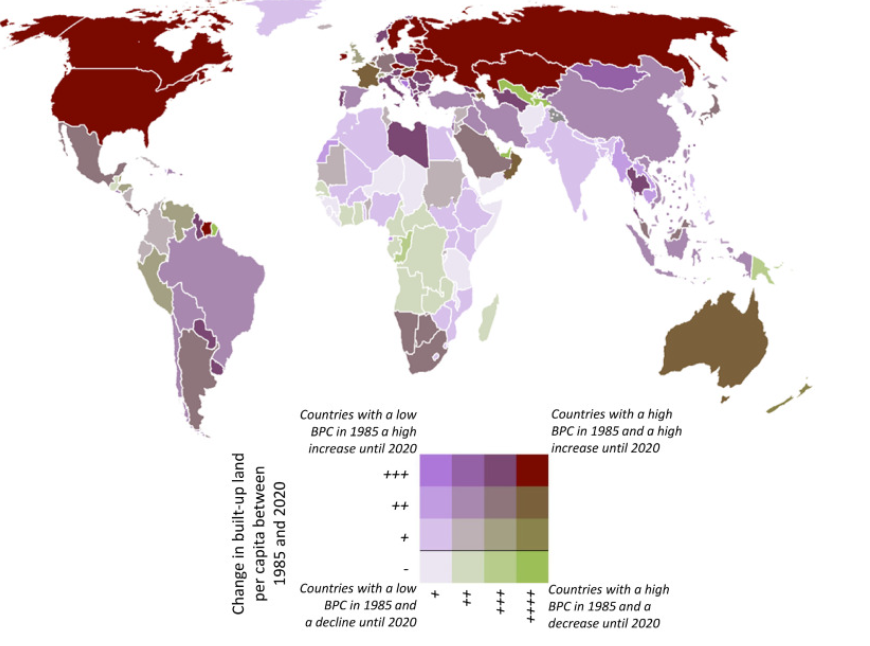
Utilities and Services
Electricity, water supplies, sewage systems, the internet and hospitals are all essentials of modern life. Constructing this infrastructure is prohibitively expensive. Governments and companies have a natural incentive to invest in places where large number of people already live, in effect creating a reinforcing cycle.
In these very remote areas, such essentials are frequently not available, and therefore the places are unappealing. Why should families move where electricity is not dependable, and water is dirty when cities provide them?
Rules That Rewrite Nations: Government Policies
New Cities and SEZs
Some governments have policies to actively try to redistribute population. The creation by China of Shenzhen, which went from a fishing village into a city whose population has swelled to more than 12 million, demonstrates how the government can plan and build urban centers virtually out of nothing.
Brazil constructed Brasília in the interior of the country, in part to spread population from coastal regions. Even as the lavish spending drew government workers and businesses, most Brazilians remain partial to coastal cities such as São Paulo and Rio de Janeiro.
Migration Restrictions
Some nations have restrictions on internal migration. China’s previous hukou system, which dated back hundreds of years, denied the possibility of a permanent move to the city for many rural residents. Reforms have loosened these rules, but the system continues to shape the country’s population distribution.
Other nations provide the opposite: Broad travel freedom. People in India are legally allowed to go anywhere they want within the country, and this has helped rapid urbanization and population concentration in big cities.
Agricultural Policies
How government manages agriculture influences amounts of the rural population. Nations that subsidize small farms and rural infrastructure sustain far more dispersed peoples. Those who believe in large-scale industrial agriculture see people moving away from the countryside to cities.
The Population Distribution Table
| Country | % Living in Urban Areas | Principal Concentration of Population | Main Geographic Factor |
|---|---|---|---|
| Australia | 86% | Coastal southeast | Desert covered interior |
| Egypt | 43% | Nile River valley | Surrounded by Sahara Desert |
| Canada | 82% | Southern border area | Arctic regions to the north |
| Russia | 75% | West | Siberian cold east |
| Brazil | 88% | Coastal Southeast | Interior is Amazon rainforest |
| China | 64% | Eastern coastal provinces | Mountains and deserts inland |
| India | 35% | Northern plains, coastal cities | Himalayan Mountains in north |
| Japan | 92% | Pacific coast | Mountainous interior |
The Push and Pull Effect
Population distribution is ultimately a question of push and pull forces — what pushes people away from some places and pulls them to others.
Push factors (driving people away):
- No employment and economic prospects
- Poor infrastructure and services
- Harsh climate or difficult terrain
- Political instability or conflict
- Environmental disasters or degradation
- Restricted education and healthcare facilities
Pull factors (attracting people):
- Job opportunities and higher wages
- Better schools and universities
- Quality healthcare facilities
- Modern infrastructure
- Entertainment and cultural activities
- Political stability and safety
- Pleasant climate and environment
These factors work together. Someone could flee the stagnant job market in a rural village (push) to move to a city with more employment possibilities (pull). Multiply that decision by millions of people, and you have our uneven population patterns today.
Technology’s Growing Impact
Remote Work Revolution
Recent technological shifts, such as the ability to work remotely, may reshape population distribution. If workers can work anywhere there’s an internet connection, they won’t be tethered — or be willing to pay a premium — for crowded, expensive cities.
There are already some countries for which the transition plays out. Americans are fleeing pricey coastal cities for more affordable places further inland. The Covid-19 pandemic hastened this shift, showing that many jobs do not require a physical office presence.
Agricultural Technology
Fewer people are required to produce more food thanks to modern farming technology. One farmer with modern equipment can work land that was tilled traditionally by dozens of men. This raises farm output but lowers the rural population, since fewer farm jobs are available.
Communication and Education
Internet access is erasing certain barriers to existing in remote areas. Online school and telemedicine and ways to pass the time with digital entertainment make remote locations more livable. But that doesn’t help places without reliable internet infrastructure.
Environmental Concerns and Future Patterns
Climate Change Effects
Where people can comfortably live will be rewritten by rising temperatures and shifting weather patterns. Some parts of the globe might become too hot or prone to flooding for human habitation, while frozen areas that now cannot sustain human populations could provide warmer havens.
Researchers say swathes of the Middle East and North Africa could become nearly uninhabitable because of rising temperatures. Simultaneously, northern Canada and Siberia could find themselves the site of population growth as warming opens these territories up.
Water Scarcity
Future settlement patterns will be highly correlated with water supply. Areas with stable water will draw people, where those without it suffer population loss. This is already happening in some parts of the American Southwest and Australia.
Sustainable Development
The combination of population distribution and environmental protection is a difficult problem. Protecting forests, wetlands and wildlife habitats will mean either outright prohibitions on human settlement in many areas or the strict regulation of these lands. National parks and protected areas intentionally maintain low population density.
Real-World Examples: Country Spotlights
Mongolia: The Extreme Case
Mongolia demonstrates extreme population concentration. Almost half of the country’s three million people live in the capital, Ulaanbaatar. The countryside itself is nearly empty, with nomadic herders roaming the grasslands. This imbalance is due to severe winters, poor infrastructure and the absence of economic prospects beyond the capital.
The Netherlands: Balanced Distribution
The Netherlands demonstrates how small nations can attain a more balanced pattern of population settlement. An advanced infrastructure, flat land and a temperate climate permit peaceful living across the country. No neighborhood feels like a place out on the margins of opportunities.
Indonesia: Island Imbalance
Indonesia spans thousands of islands, but Java island is home to more than half the country’s 275 million people despite accounting for just 7% of the land area. This imbalance was the result of historical factors (Java was colonial administrative center), fertile volcanic soil, and concentrated development. The government deliberately seeks to promote migration to other islands with transmigration programs.
The Urban Explosion
Megacity Growth
The world is rapidly urbanizing. In 1950, cities were home to just 30% of the population. Today, more than 55% of the public feels that way — and the numbers keep climbing. By 2050, some experts predict that almost 70 percent of humanity will live in cities.
This urbanization leads to megacities — cities of more than 10 million people. Tokyo, Delhi, Shanghai, São Paulo and Mexico City illustrate this move. These are enormous population concentrations that also present opportunities and challenges, have helped to shape the future of culture.
Benefits of Concentration
Concentrated populations offer advantages:
- Efficient infrastructure and services
- Diverse job markets
- Cultural diversity and innovation
- Better educational institutions
- Enhanced healthcare facilities
- Public transportation networks
Problems of Overcrowding
But to go too far is disastrous:
- Traffic congestion and pollution
- Housing shortages and high costs
- Pressure on water and electricity provision
- Waste management challenges
- Social inequality and slums
- Loss of green spaces
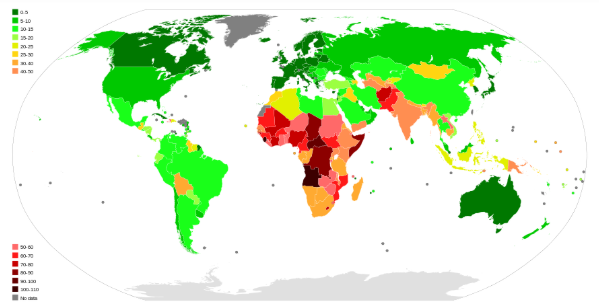
Why Some Countries Have Uneven Populations
What This Means for Your Life
The consequences for all affected aren’t recognized, whether or not you know it:
If you live in a bustling city, you face stiff competition for housing and jobs, but have access to good services and opportunities.
You may get more space and smaller bills, but also a limited selection of jobs and fewer specialized services if you’re in a rural area.
For business owners, population distribution helps them decide where to put stores or factories for the highest likelihood of success.
For governments, such patterns affect where to invest in infrastructure, how best to deliver services and how to keep regional development relatively balanced.
For the environment, concentration of population can help combat sprawl and save natural lands, but it also brings intense local environmental pressure.
Frequently Asked Questions
Q: Why do people keep moving to cities that are already crowded?
A: Cities have more stable sources of employment, higher pay scales, better education system, improved health facilities and various forms of entertainment. Yet despite the crowds and high prices, many find the trade-offs well worth it compared to less opportunity back in rural centers.
Q: Can governments force people to move to less populated areas?
A: Some governments do so by giving positive incentives (tax breaks, free land, subsidized housing) or in making it more difficult for people to move. But coercion does not work that way as a long-term strategy of redistributions. People gravitate to better options and the restriction of movement raises human-rights issues.
Q: Will tech eventually distribute populations more evenly?
A: Possibly. Some may choose to leave costly cities if remote work, online education and better rural infrastructure allow them to do so. But people are social animals who usually willingly live near others, so total evening out does not seem plausible.
Q: What are the countries with the most unevenly distributed population?
A: Australia and Canada, along with Russia, Mongolia and Egypt are among the most unequal. These countries are vast but tend to focus their people in limited areas because of climate, geography or history.
Q: Why is uneven distribution of a nation’s population not good?
A: Not necessarily. It depends on the circumstances. Some places are simply too poor, geographically speaking, to hold masses of people. But radical imbalance, too, can lead to problems such as overpopulated cities, abandoned rural areas and inefficient use of resources.
Q: How do shifts in population distribution translate into politics?
A: In democracies, densely inhabited areas tend to have more political influence because they are home to more voters. This may result in government policies being biased towards urban sectors and neglecting the peripheries, thus setting up a mutually reinforcing mechanism.
The Bottom Line
Uneven population distribution is no mystery once you look into the equations. Geography is the bottom layer — no one prefers mountains, deserts and tundra to flat, temperate and well-watered places. The past shouldn’t be buried; it should be left to lie thick and slumbering, layer on layer, history upon history, ancient upon medieval or modern. Economic factors push modern movement, attracting people to jobs and opportunities. Such natural/historic tendencies are encouraged or confounded by government policies and infrastructure investment.
Every country faces unique circumstances. Island countries are not the same as Continental powers. Desert nations face different challenges from tropical ones. Smaller, crowded countries work differently than huge countries that are sparsely populated.
The critical point is that the distribution of people changes all the time. What is true today may be immeasurably different in fifty years. Climate change, technology, economic changes and political developments all shape where we want to live. Tomorrow’s population maps could look quite different from today’s.
For now at least, the pattern seems unbroken: People group themselves where life is easiest and opportunity most plentiful; huge expanses of the Earth remain thinly settled or not at all. This skewed distribution shapes everything from the cost of real estate to political power, environmental impact and cultural development.
Next time you stare at a map, consider all those population patterns and the stories they tell — of human adjustment, ambition and the timeless quest for a better life. There’s something fascinating that goes on between geography, history and human choice behind every swollen city and isolated desert.

